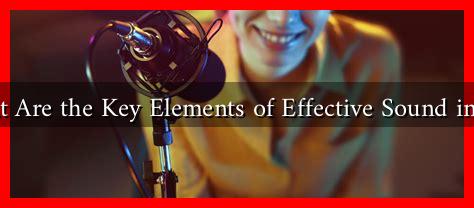-
Table of Contents
What Are the Key Elements of Effective Sound in Ads
In the world of advertising, sound is often an underappreciated element that can significantly influence consumer behavior. From jingles to voiceovers, the auditory components of an advertisement can evoke emotions, create brand recognition, and enhance the overall message. This article explores the key elements of effective sound in ads, providing insights into how brands can leverage audio to maximize their impact.
The Power of Sound in Advertising
Sound plays a crucial role in shaping our perceptions and emotions. According to a study by the American Marketing Association, ads that incorporate sound elements can increase brand recall by up to 50%. This statistic underscores the importance of sound in creating memorable advertising experiences.
Key Elements of Effective Sound in Ads
To create effective sound in advertisements, several key elements must be considered:
- Music: The right music can set the tone and mood of an advertisement. It can evoke emotions and create a connection with the audience. For example, Coca-Cola’s use of upbeat, cheerful music in their holiday ads creates a sense of joy and nostalgia.
- Voiceovers: A well-delivered voiceover can enhance the message of an ad. The tone, pitch, and pace of the voice can convey authority, friendliness, or urgency. For instance, the calm and reassuring voice of Morgan Freeman in various commercials adds credibility and trustworthiness.
- Sound Effects: Sound effects can add realism and enhance storytelling. They can draw attention to specific elements within the ad. For example, the sound of a soda can opening in a Pepsi ad immediately evokes the refreshing experience of drinking the beverage.
- Jingles: Catchy jingles can make a brand unforgettable. A well-crafted jingle can stick in consumers’ minds long after they’ve seen the ad. The “I’m Lovin’ It” jingle from McDonald’s is a prime example of how a simple tune can become synonymous with a brand.
- Silence: Sometimes, less is more. Strategic use of silence can create tension or emphasize a key message. For example, a sudden pause in dialogue can heighten anticipation and draw the audience’s attention to what comes next.
Case Studies: Successful Use of Sound in Advertising
Several brands have successfully harnessed the power of sound in their advertising campaigns:
- Apple: Apple’s ads often feature minimalist sound design, focusing on clear voiceovers and subtle background music. This approach aligns with their brand identity of simplicity and sophistication, making their products feel more accessible and desirable.
- Old Spice: The Old Spice “The Man Your Man Could Smell Like” campaign utilized a humorous voiceover and quirky sound effects to create a memorable and entertaining ad. The combination of these elements contributed to a significant increase in sales and brand awareness.
- Intel: The Intel “bong” sound is a perfect example of how a simple audio cue can become a powerful brand identifier. This sound is instantly recognizable and has become synonymous with the brand, reinforcing its presence in consumers’ minds.
Statistics Supporting the Impact of Sound
Research has shown that sound can significantly influence consumer behavior:
- According to a study by Nielsen, ads with sound are 23% more effective than those without.
- Another study found that 96% of consumers believe that sound is an important factor in their overall experience with a brand.
- Brands that use music in their ads see a 20% increase in purchase intent compared to those that do not.
Conclusion
In conclusion, effective sound in advertising is a multifaceted element that can greatly enhance a brand’s message and consumer engagement. By carefully considering the use of music, voiceovers, sound effects, jingles, and even silence, brands can create memorable and impactful advertisements. As demonstrated by successful case studies and supported by compelling statistics, the strategic use of sound can lead to increased brand recognition, consumer loyalty, and ultimately, sales. As the advertising landscape continues to evolve, brands that prioritize sound will likely find themselves at a competitive advantage.

